Analysis of standard system based on NFC communication
Foreword
In recent years, NFC (Near Field Communication) technology has been valued worldwide, and all parties in the industry chain such as terminal manufacturers, content providers, equipment manufacturers, and telecom operators are actively participating in the application research of NFC. . The International Standards Organization has conducted research on various NFC-based applications and has introduced various standards and specifications.
With the continuous development and maturity of short-range wireless technology, especially the rise of Wireless Personal Area Network (WPAN), short-distance data services have developed rapidly, combined with Radio Frequency IDentification (RFID) and wireless connectivity. The technology developed NFC technology will become one of the competitive short-range wireless communication technologies. Compared with other short-range wireless communication technologies, NFC has the characteristics of short communication distance, short connection establishment time, low energy consumption requirement, high security, simple network topology, low cost, convenient and easy to use, and intuitive. The existing contactless smart card technology is compatible with each other. Therefore, NFC technology is very suitable for the contactless service of mobile intelligent terminals, and realizes the rapid exchange of important data such as financial information or sensitive personal information.
The maturity of NFC standards and technologies makes them widely used in mobile payments, e-ticketing, smart media, identity, social entertainment and electronic devices. With the rapid promotion of NFC services, telecom operators have new challenges in information integration capabilities and operational models. On the one hand, we should rely on NFC products to improve user satisfaction and user stickiness, and further focus on NFC product use and customer experience and service guarantee; on the other hand, we should focus on open sharing, strengthen industry and cross-industry exchanges and cooperation, and effectively use resources; Fully drawing on the mature experience of the same industry at home and abroad, based on the NFC-based business system model and standard system framework, analyzing the communication standards of the execution domain and the management domain, is the operator's vigorous development of NFC business, and plays an active role in the optimization of NFC industrial environment. Premise.
1 Standard system based on NFC communication
1.1 Business System Model Based on NFC Communication
NFC technology itself is only a communication interface of equipment as a communication method. At present, the international promotion is to promote NFC technology as a service from the perspective of 'NFC as a Service'. This is the starting point of this paper study to operate NFC as a business. The specific business system architecture is shown in Figure 1. 1) NFC service platform. As an operation and service management platform for NFC services, it has functions such as service opening and closing, provision of user demand information, collection and maintenance of user behavior information, maintenance of intelligent information terminals, and remote update of software. 2) Intelligent information terminal. As an NFC service platform, it extends to the front-end terminal of the user's ecological environment, providing users with NFC services at their fingertips. It has the functions of performing NFC interaction with intelligent terminals and submitting user requirements to the service platform for processing. 3) Intelligent terminal. As a carrier for providing users with NFC services, it mainly serves as a human-machine interface, and realizes push of services through interaction between an intelligent terminal and an NFC of an intelligent information terminal.
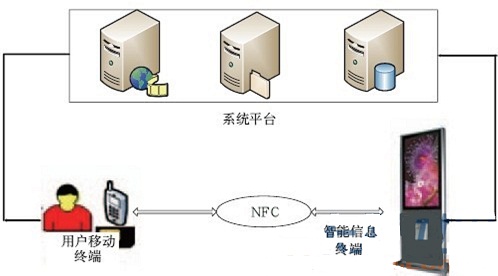
Figure 1 NFC business system architecture
Based on the role requirements of the above NFC service operations, we divide the NFC service system model into two parts: the management domain and the execution domain, which are connected through the data upload channel and the data downlink channel, as shown in Figure 2. 1) Management domain. It is an NFC service platform that corresponds to the system architecture diagram for the operation and development of NFC services, business management, and user data processing. 2) Execution domain. The user-oriented NFC ecosystem is really close to the users themselves, carrying out specific NFC-based services; intelligent information terminals and intelligent terminals corresponding to the system architecture diagram.
1.2 Standard architecture based on NFC communication
The development of NFC services and technologies is mainly based on the development of standards. The international organizations around NFC technology and related standards mainly include ETSI, ISO/IEC, NFC-Forum and GSMA. With the development of mobile payment services and the formulation and release of industry standards, the domestic requirements for the underlying NFC technology and technical requirements have also been made.
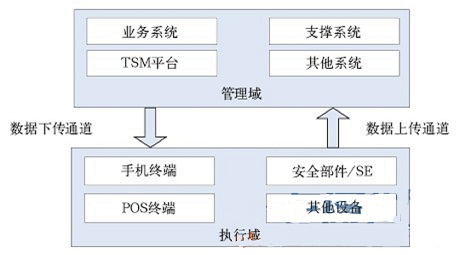
Figure 2 NFC business system model
According to the NFC service system model shown in Figure 2, the existing NFC technical standards are mainly divided into two parts, namely, the implementation domain technical standard and the management domain technical standard. Among them, the implementation domain technical standards are mainly formulated by ECMA, ISO/IEC, ESTI and NFC-Forum organizations. The main officially released standards of GSMA are based on the principle of interoperability and practicability of NFC technology. The requirements of the SIM-based solution are the requirements, and both the execution domain and the management domain are involved. The standard architecture framework based on NFC communication is shown in Figure 3.
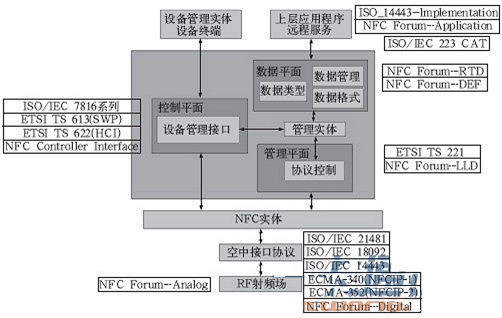
Figure 3 SIM-based standard architecture framework
In order to integrate NFC service resources, improve the value of NFC applications, and realize the interoperability of NFC services and the development of NFC technical standards, the implementation of standards in the underlying implementation domain should be standardized and unified, paving the way for the versatility of business applications, and the upper management domain standards are implemented. Interoperability between platforms.
2 Unified NFC communication standard for the execution domain
2.1 International NFC communication standards
The existing international implementation domain NFC technical standards are mainly divided into two parts, namely the physical layer protocol part and the application layer protocol part. The physical layer protocol part is mainly completed by ECMA, ISO/IEC and European Telecommunication Standardization Association (ESTI), and the application layer protocol is mainly developed by NFC-Forum organization. GSMA has released a small number of application layer standards, which are intended to support mobile phones such as SWP and UICC. application.
2.1.1 Physical Layer NFC Communication Standard
The original implementation domain protocol is NFC Interface Protocol 1 (NFCIP-1) [1], a short-range wireless communication technology mainly promoted by Philips, Nokia and Sony. The NFCIP-1 standard specifies the modulation scheme, coding, transmission rate, and frame format of the RF interface for NFC devices, as well as the initialization schemes and conditions required for data collision control during active and passive NFC mode initialization. In addition, these standards also define transport protocols, including protocol initiation and data exchange methods. Philips, Nokia and Sony submitted the draft NFCIP-1 standard to ECMA International, numbered ECMA-340. After review and revision by ECMA, ECMA submitted the standard to ISO/IEC and was identified as the standard ISO/IEC 18092 [2] The protocol also applies ISO/IEC 23917 and ISO/IEC 22536, both of which cover NFC test methods, including protocol test methods and RF/IF test methods. NFCIP-1 was approved by ETSI in 2003
For TS 102 190 v1.1.1 [3]. See Table 1 for physical layer NFC communication standards published by ECMA.
Table 1 Physical layer NFC communication standards published by ECMA

In order to be compatible with contactless smart cards, NFC-Forum introduced the NFCIP-2[4] specification in 2004 and was approved by relevant organizations as ECMA-352, ISO/IEC21481 and ETSI TS 102 312 V1.1.1. NFCIP-2 refers to ISO/IEC 14443 [5] and ISO/IEC 15693 [6] on the basis of the original NFCIP-1, and is ISO/IEC 21481 in 2005. The improved version specifies a flexible gateway system for detecting and selecting one of three modes of operation: NFC card emulation mode, reader mode, and peer-to-peer communication mode. After the selected mode is selected, subsequent actions are performed according to the selected mode. See Table 2 for the physical layer NFC communication standards published by ETSI.
Table 2 Physical layer NFC communication standards published by ETSI
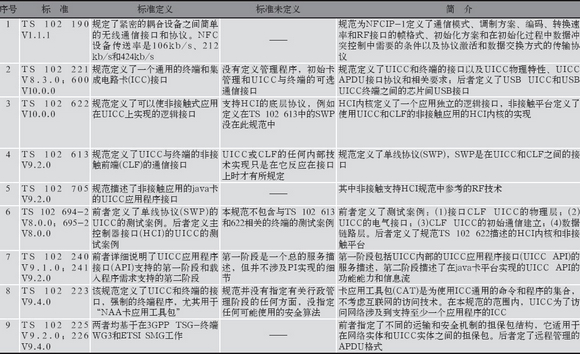
NFC-related standards issued by ISO and NFC-related standards and smart card-related standards are cited in NFC-related specifications. ISO/IEC-13157-1 and ISO/IEC-13157-2 define the NFC-SECNFCIP-1 security services and protocols [7] and the encryption standards for ECDH and AES used by NFC-SEC. ISO/IEC-14443 defines the application of contactless cards, specifying the physical characteristics of the card, signal energy and signal interface, initialization and anti-collision characteristics of the card, and data transfer protocol for the card. ISO/IEC-15693 defines air interface and data communication specifications for smart tags and readers operating at 13.56 MHz. ISO/IEC-7816 [8] specifies the relevant specifications for contact smart cards, including physical characteristics, interface specifications, transmission protocols, and command exchange formats. See Table 3 for the physical layer NFC communication standards published by ISO.
Table 3 Physical layer NFC communication standard published by ISO

Based on the above analysis of the international NFC standard, the evolution of the physical layer NFC standard is obtained, as shown in FIG.

Figure 4 Evolution diagram of NFCIP
2.1.2 Application Layer NFC Communication Standard
The application layer protocol mainly defines the data structure of the specific application, the communication protocol, and the interoperability between the NFC devices. In addition, the functions and specifications of the application layer protocol are basically formulated with reference to the physical layer protocol.
In June 2006, NFC-Forum introduced a standardized technical framework, initial specification and tag format for NFC-compatible devices, including data interaction formats (NDEF) and records for smart posters, text and Internet resource reading applications. Three initial specifications for type definition (RTD). With the further development of standards development, in 2011, the NFC-Forum Forum further updated the label format. The initial label format chosen for the widest range of applications and device performance, in addition, the NFC-Forum Forum announced the initial setup of the four tag formats that all NFC-compatible devices must support, making NFC-enabled tags an application. The most important component of the layer protocol. Each label is based on ISO/IEC 14443-A or ISO/IEC 14443-B or Felica (a passive communication mode standard derived from ISO/IEC 18092) proposed by SONY Corporation. Labels of Type 1, 2, and 3 were originally supplied exclusively by companies such as Innovision, Philips, and SONY. Type 4 labels are currently available from many manufacturers and other suppliers. The application layer NFC communication standard issued by NFC-Forum - see Table 4 for data definition and Table 5 for protocols and specifications.
Table 4 Application Layer NFC Communication Standards Released by NFC-Forum - Data Type Definition

Table 5 Application Layer NFC Communication Standards Released by NFC-Forum - Protocols and Specifications
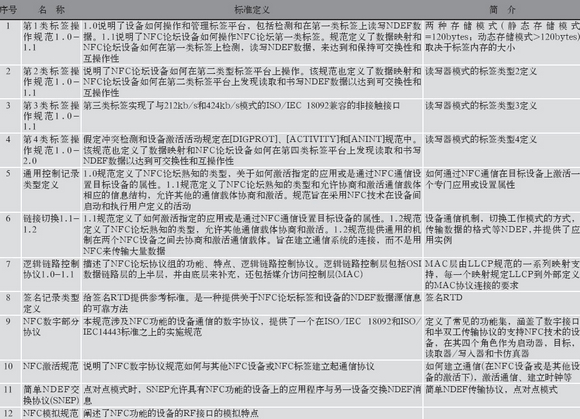
In 2011, GSMA released the single-line protocol requirement specification for NFC mobile phones, supporting mobile phone near-field communication solutions, and promoting the availability of single-line protocol (SWP) NFC mobile phones required by mobile network operators (MNOs) to provide mobile network operators that specify mobile phone demand. Guidance, intended to support UICC-based mobile NFC services.
In November 2012, GSMA released the NFC Multi-Protocol Interoperability White Paper, which sets requirements for handset manufacturers and Proximity Coupling Devices (PCDs) that interact with NFC phones and UICCs, and is limited to card emulation mode and non-contact interactive peer-to-peer mode. . There are no new parameters defined that do not conform to the ISO 14443 standard. This white paper lays the groundwork for coordinating and unifying the common non-contact technologies that exist on the same ecosystem platform. See Table 6 for the application layer NFC communication standards published by the GSMA.
Table 6 Application Layer NFC Communication Standards Released by GSMA

2.2 Domestic NFC communication standards
In China, with the development of mobile payment services and the development and release of industry standards, the technical requirements for the underlying NFC technology are also stipulated, mainly including the mobile industry mobile payment standards issued by the Bank of China, and radio-based mobile Pay national standards.
2.2.1 China Financial Mobile Payment Industry Standard
The mobile industry mobile payment series standard [10] was released by the People's Bank of China in December 2012. A total of 35 standard specifications were issued around the remote payment method and the near-field payment method of mobile payment. The standard consists of four parts: data element, transaction model and process specification, message structure and elements, and file data format specification.
The data element standard can effectively enhance the interconnection and information sharing between commercial banks, non-financial payment institutions and merchants, and improve the ability of all parties to jointly resist financial risks. The transaction model and process specification abstract and standardize the relevant transaction models and processes in the current near-field payment business; the message structure and the element specification standards abstract and standardize the more mature general message interfaces in the current mobile payment field; The Data Format Specification standard abstracts and normalizes the more mature and common file data formats in the mobile payment field.
2.2.2 National Standard for Mobile Payment Based on Radio Frequency
The national standard for mobile payment based on radio frequency [11] is divided into five parts, namely RF interface, card technical requirements, equipment technical requirements, application management and security, and RF interface test methods. The RF interface specifies the RF interface of the RF-based mobile payment system; the card technology requirements apply to the design, production and use of RF-based mobile payment cards; the device technology is suitable for the design and production of RF-based mobile payment devices; application management and It is safe for the design, production and use of mobile payment cards; the RF interface test method specifies the RF interface test method for RF-based mobile payment cards and devices.
3 Management domain NFC communication standard interworking
3.1 International NFC Communication Standard
The international management domain NFC communication standard mainly includes the technical and business requirements white papers formulated by the GSMA, the operator's mobile payment service operation guide, and the guidelines for SP application development. The technical white paper describes the TSM service model. The business requirements white paper covers air travel, retail, and transportation. It lists the frameworks for mobile NFC services for service providers composed of banks, retailers, transportation operators, and mobile operators.
3.1.1 NFC Technical Requirements White Paper
In 2010, EPC-GSMA released the requirements and specifications for trusted service manager service management, defining requirements and specifications for different service management roles involved in the opening and lifecycle management of mobile contactless payment services, and for possible TSM services. The model provides a description.
In October 2012, the GSMA released the NFC UICC requirements specification white paper, which lists the general framework for UICC requirements to support UICC-based NFC devices. The white paper lists the minimum set of requirements for NFC UICC and the development of identification technology gap specifications to ensure effective and consistent NFC devices. The management domain NFC technical white paper released by GSMA is shown in Table 7.
Table 7 Management Domain NFC Communication Standards Released by GSMA - Technical White Paper
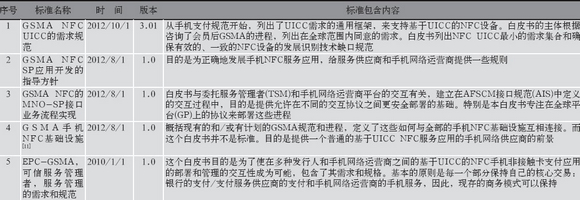
3.1.2 NFC Business Requirements White Paper
Mobile NFCs released by GSMA in 2011-2012 A series of white papers in the air travel, retail, and transportation industries focus on UICC (usually referred to as SIM cards inside mobile phones) solutions to ensure the security of services. The UICC-based solution meets international security standards and provides a worldwide user experience that is independent of the type of handset. The above white paper addresses mobile NFC solutions in the aerospace, retail, and public transportation sectors in Europe and other developed markets (such as Korea and Japan), and provides a reference for mobile NFC services in related areas in other countries.
In February 2011, the GSMA released a white paper on hand ticketing, which strengthened and improved the role of mobile phones in the ticketing service and ticketing service value chain, providing a powerful and convenient way for consumers to use the mobile phone secure UICC to buy tickets and collect tickets.
In October 2012, GSMA released a mobile wallet white paper listing the framework for mobile NFC services for service providers comprised of banks, retailers, transport operators and mobile operators. The management domain NFC business white paper released by GSMA is shown in Table 8.
Table 8 Management Domain NFC Communication Standards Released by GSMA - Business White Paper

3.1.3 Other technical discussion papers
In April 2011, the GSMA released a mobile payment service operation guide for mobile network operators, providing guidance for GSMA mobile network operators to develop commercial deployment service operating specifications based on UICC mobile NFC services. At the same time, mobile network operators are seeking to reach consensus with operators of other ecosystems in their respective markets.
In August 2012, the GSMA released guidelines for NFC SP application development, providing some management rules for service providers and mobile network operators to correctly develop mobile NFC service applications. At the same time, GSMA released NFC's MNO-SP interface business process implementation and mobile NFC infrastructure, the former laying the foundation for the interaction between the Trusted Service Manager (TSM) and the mobile network operator platform, which summarizes existing and/or existing Planned GSMA specifications and processes, and define how these are interconnected with mobile NFC infrastructure to provide mobile network providers with a UICC-based NFC service application prospect. See Table 9 for additional technical contributions to the management domain NFC communication standard published by the GSMA.
Table 9 Management Domain NFC Communication Standards Released by GSMA - Other Technical Contributions

3.2 Domestic NFC communication standards
The domestic management domain NFC standard currently only agrees on the standards of the TSM platform. Mainly in accordance with the relevant technical requirements of the "Global Platform Card Specification", the technical requirements of the TSM platform and the operation and management of the card application are formulated. In the networking mode of the management domain, the current technical requirements and interoperability related to TSM in China mainly include the industry standard of the Chinese financial mobile payment industry standard for the trusted service management technical specification and the card application management platform for each enterprise for the enterprise. Specification.
3.2.1 China Financial Mobile Payment Trusted Service Management Technical Specification
The specification [12] specifies the service model of the mobile payment trusted service management system, the interconnection structure, the SE security and the SE open sharing, and also defines the main functions, business processes, application interfaces of the public service platform and the TSM platform. System security requirements. The main contents include the following 2 points.
1) Mobile payment trusted service management system architecture and implementation and interconnection. As a credible basic measure of mobile payment, the mobile payment trusted service management system builds the foundation of secure and credible mobile sharing, open sharing, multi-application coexistence and interconnection. In the scheme of realizing the mobile payment trusted service management system, two different interconnection structures, star and mesh, are formed according to the interconnection mode, and the mesh interconnection structure can be used as an excessive networking scheme of the star interconnection structure.
2) Public service platform and TSM platform system functions. The public service platform is a trusted third-party entity recognized by all parties involved in mobile payment, and provides institutional registration access, application registration, cross-institutional interaction routing for TSM platform operators, SE issuers, application providers, service providers, and users. SE trusted, SE open sharing and application sharing. The TSM platform is aimed at SE issuers and service providers, and provides basic services through the use of public service platforms, registration of SEs, creation of security domains, and downloading and personalization of business applications.
3.2.2 China Unicom Java Card Integrated Business Management and Download Platform Technical Specification v2.0 This specification [13] was formulated based on the relevant industry standards and combined with the characteristics of China Unicom's Java Card business. Mainly based on the "GlobalPlatform Card Specification" on the Java Card Multi-application management process, the requirements and contents of the Java Card integrated business management and download platform application process are comprehensively required. This technical specification is aimed at the management and process of Unicom Java Card application, and clarifies the technical functional requirements of the Java Card integrated service management and download platform and the technical conditions for technical function construction.
4 Summary
Based on the analysis of the mainstream and relatively mature technologies and business standards and industry and enterprise standards in the field of mobile payment at home and abroad, we have found that the NFC technical specifications are constantly improving, and the NFC services are gradually unified at the technical level, which is the interoperability for subsequent NFC services. It laid the foundation, but there are still some shortcomings.
1) Some of the standards for the implementation domain need to be further refined. Although the relevant standards organizations continue to improve the physical layer and application layer communication standards, there are still some areas for improvement in some communication standards of the execution domain. As ETSI's TS 102 223 specification does not specify any aspect of the administrative phase, any internal technical implementation of the ICC or terminal is defined only in the specification of the reactive interface and does not specify any security algorithms that may be used; for UICC applications The first phase of interface (API) support has only one general service description and does not cover the details of the implementation.
2) The management domain interworking model is not defined. The white paper on mobile phone wallet released by GSMA lists the framework for implementing mobile NFC services in different industries, but it is limited to each industry and does not realize interoperability in various industries. The domestic NFC standard currently only agrees on the standards of the TSM platform, and there is no unified definition of the interoperability architecture model.
However, with the improvement of various standards, it has laid a solid foundation for the realization of operator-led NFC service interoperability. 1 More NFC solutions focused on UICC (usually referred to as SIM cards inside mobile phones) ensure the security of NFC services. UICC-based solutions comply with international security standards and provide a worldwide user experience independent of mobile phone types. 2 Operators of more NFC ecosystems will gradually recognize the role of mobile network operators in the ecosystem and the importance of creating a successful mobile NFC ecosystem service operation. 3 Existing standards provide mobile TV network providers with a bright future for UICC-based NFC service applications.
With the gradual popularization of NFC technology in China, NFC-related applications have been launched around the NFC industry chain. Especially driven by the mobile payment service, major telecom operators in China have increased their development efforts and started commercialization of NFC services. With the continuous development of telecom operators in the NFC field, the operator-led mobile payment market will usher in a clear growth period, and the operator's operating mode and cross-border cooperation will enter a new stage.
China Unicom, which already supports the commercialization capabilities of the UnionPay NFC standard, faces the challenges and opportunities brought about by the continuous development and application of NFC technology. It needs to further strengthen exchanges and cooperation with industry resources and actively transform its operating model before it can be in the fierce technology. The wave of reforms and the era of big data flows have stabilized and developed. (Author: Yin Xia, Master, Engineer, mainly engaged in mobile internet, industry informationization and standardization research. Gu Yuxia, Master, Director of Technical Standards Management Department, Technical Department of China United Network Communications Co., Ltd., Vice Chairman of CCSA TC5. Research direction is SIM card, mobile terminal, service platform technology and Internet of Things technology and standardization research.)
Over 11 years experience on production of gaming chairs , Brand of JUDOR pay more attantion to the products inside material, After a lot of improvement makes the structure more reasonable more comfortable of sit feeling. more longer using time and more environmental protection material !
China manufacture manager leather swivel executive Kneeling chair for office furniture
Value is at the core of the Judor brand but that doesn`t mean Judor cuts corners. Judor offers powerful, cool, and easy to use tech that cover the staples of accessories. We provide the customer an excellent product at an impulse/entry level price that can`t be beat.
ergonomic design kneeling chair leather fabric chair for typing high back kneeling chair
Modern Rocking Wooden Ergonomic Office Kneeling Chair or Knee Chair with Backrest Back Support
The perfect chair for desk work. It keeps the spine in its natural position and strengthens the back muscles. With an angle greater than 90 degrees between torso and thighs breathing is enhanced. Through the constant natural movement, tensions in the back, neck and shoulders will be prevented while blood circulation and oxygen supply is activated. You will feel the effect right away sore muscles as a sign of the new training. It is best to better start with short sitting periods in the first week. Enjoy unlimited comfort and take advantage of increased well being and an alert mind.
Kneeling Chair,Ergonomic Kneeling Chair,Kneeling Stool,Kneeling Office Chair
Anji Judor Furniture Co., Ltd. , https://www.cnjudor.com